The dragon coils in its barrow, ancient and terrible. For over a century it has guarded its hoard of gold and jewels, each piece memorized, each cup, ring, and twisted armband known by touch in the darkness.
Then, one night, a thief creeps in. He takes just a single cup — one piece among thousands. But, for the dragon, this is enough.
The beast's reaction seems extreme: it rises from its lair and lays waste to the countryside, destroying hall and home, raining fire and death down over an entire kingdom — all because of a single stolen cup.
This is the story that sets off the action in the final third of Beowulf, the greatest surviving heroic poem from Anglo-Saxon England. Composed sometime between the 8th and 11th centuries AD, Beowulf reflects the values of the Germanic peoples who settled Britain in the early medieval period.
The dragon's violent response reveals something about how early Germanic peoples conceived of these beasts. They were not simply big, scary creatures who happened to like shiny things. What makes Germanic dragons unique isn't that they guard treasure. It's that they seem to exist only to guard treasure. They don't spend their wealth or enjoy it. They simply keep it from everyone else, and react with apocalyptic violence when even the smallest piece escapes their grasp.
Dragons were enemies of the social order, who had one purpose: to keep wealth from circulating through society. But to understand why Germanic storytellers imagined them in this way, we need to look deeper — both into Germanic legends themselves, and into the even more ancient myths that shaped them.
When serpents held the world hostage
Long before dragons guarded gold in Beowulf and other Germanic stories, they hoarded something even more precious — the waters of the world. In an Indian myth that dates back thousands of years, the storm god Indra slays the serpent Vritra, who has coiled around the world's waters, causing a drought.
With his thunderbolt, Indra splits the serpent's belly, and “let the floods go free, like cows imprisoned.” (Rigveda I.61.10) Life returns to a parched earth, and agriculture, the foundation of civilization, becomes possible.
The symbolic significance of Indra killing Vritra isn’t exactly subtle — Vritra is a Sanskrit word which literally means ‘obstacle.’ By slaying the serpent, Indra removes the obstacle standing in the way of order in the world.
This pattern — god/hero kills serpent/dragon, and establishes order in some way — appears across cultures descended from the ancient Indo-European peoples, a prehistoric group whose migrations spread languages and myths from Ireland to India: The Greek Zeus — another storm god — defeats the serpent Typhon. The Hittite storm god Tarhunna slays the dragon Illuyanka. Thor, the thunderer, battles Jǫrmungandr, the World Serpent.
These myths aren't just stories about epic battles. They're about cosmic economics — the proper flow of resources that sustain life and society. In ancient stories, dragons don't randomly terrorize — they strangle society by stopping up what should freely circulate.
The Germanic peoples inherited this ancient pattern, as in the myth of Thor and Jǫrmungandr, but they also transformed it. The theme of the serpent blocking the flow of resources remains, but by the time we get to stories like Beowulf and Vǫlsunga Saga (late 13th century AD), what needs to flow isn't water, but wealth.
From water to gold
The Beowulf dragon doesn't guard water in its lair — it guards gold, silver, and jewels. But it guards them with the same jealous intensity as Vritra guarded the cosmic waters. The dragon exists not to use this wealth, not to spend it or enjoy it, but simply to prevent its circulation.
The shift from dragons that hoard water to dragons that hoard treasure wasn't arbitrary. It reflected a transformation in how societies viewed their world. For farming communities dependent on seasonal rains, the monster who holds back water threatens life itself. But for warrior societies built on gift-exchange and tribute, the monster who hoards gold threatens the social order just as severely.
Gold wasn't simply an ornament in early Germanic societies — it was the physical manifestation of social bonds. Kings were called “ring-givers” and “gold-friends” because their generosity bound warriors to them. The circulation of treasure — passing from king to warrior, traded between peoples, buried with the dead — formed the economic backbone of early Germanic life. A king who hoarded his wealth and refused to distribute it committed a deed almost as unforgivable as murder.
This is dramatically illustrated in the story of Fáfnir (literally, ‘the Embracer’) from Vǫlsunga Saga. Originally the son of a dwarf, Fáfnir murdered his father to seize another dwarf's hoard of gold. Rather than using this wealth or sharing it, he dragged it to a remote place, laid his body over it, and physically transformed into a dragon. The moral of the story: the one who hoards wealth doesn't just act like a dragon — he becomes one.
So the dragon becomes a poetic shorthand for social death — the stagnation that occurs when resources cease flowing through the community. The Beowulf dragon illustrates this fear. Though it has guarded its treasure for three hundred years, it has never spent a single coin or worn a single armband.
Our poet calls the dragon a hordweard — “hoard-guardian” — a term that defines it by its economic function, or lack thereof. When that function is disrupted by the theft of a single cup, the dragon realizes right away — and its reaction is inevitable:
The hoard-guardian waited anxiously until evening came: […] he wanted to repay the precious cup with fire.” (Beowulf 2302–2306)
Like the drought-causing serpents of older myths, Germanic dragons existed to explain a fundamental anxiety: what happens when the things meant to circulate get stuck? The answer, in both cases, was catastrophe, whether parched fields or burning villages. And it could only be overcome through heroic intervention.
Breaking the dam
Beowulf's final battle represents this intervention perfectly. After he slays the dragon, the focus turns immediately to the treasure. The dying Beowulf asks to see the hoard, telling his retainer Wiglaf:
“Be now in haste, so that I may know the ancient treasure, the golden goods… so that, because of the wealth, I may more easily give up my life and rule, which I have long held” (Beowulf 2746–2751)
The poet tells us that Wiglaf orders the wealth carried out of the barrow, and later describes the funeral of the great hero: Beowulf's body is burned on a pyre, and the dragon's treasure is buried with him. This act mirrors real archaeological evidence from Germanic burial sites, where precious goods were interred with the dead.
But even this was probably not the end of the wealth’s journey. Archaeologists have found widespread evidence of “tomb-breaking” in early medieval Europe, where graves were later reopened and buried treasures retrieved — and reintroduced into circulation.
This circulation isn't perfect, but it has begun. The wealth that had sat stagnant for three hundred years has moved from dragon to hero to tomb, and eventually back to the community. The dam has been broken.
Just as Indra's defeat of Vritra releases the waters that agriculture needs, Germanic heroes who slay dragons free the wealth that society needs. In both cases, the hero's triumph isn't merely a triumph of arms — it’s also an act that allows for civilization to continue.
This is why dragon-slaying became the quintessential heroic deed. It wasn't just because dragons were terrifying foes whose defeat brought glory. It was because dragons threatened society itself by hoarding its lifeblood — water in the more ancient Indian myths, or gold in the later Germanic legends. The hero who defeats the dragon restores the proper order of things and makes resources flow once more.
The ancient pattern lives on
The dragon-as-hoarder pattern has proved remarkably durable in European storytelling. This old story — hero slays monster, releases blocked up resources — shaped how Europeans would imagine dragons for centuries to come. When Tolkien wrote about Smaug lying on his pile of gold in The Hobbit, he was drawing on an image that stretched back through Beowulf to ancient myths about monsters who held back the waters of the world.
Even authors who have never heard the story of Indra slaying Vritra have found themselves drawn to this primordial pattern. There's something compelling about the image of the dragon guarding its hoard — whether that hoard is of gold and treasure or of the waters that give life to a dry land.
The modern fantasy genre represents only the latest phase of this millennia-old tradition. Tolkien transmitted to us the Germanic image of the dragon as a hoarder of gold. From there, dragons have spread across books, films, and games — almost always crouched jealously over their treasures. Even when modern storytellers reinvent dragons as wise or noble creatures, they rarely abandon the association with hoarding. The Germanic dragon — the great hoarder — continues to haunt our imagination, reminding us that, no matter how many dragons heroes slay, the idea of the dragon never dies.

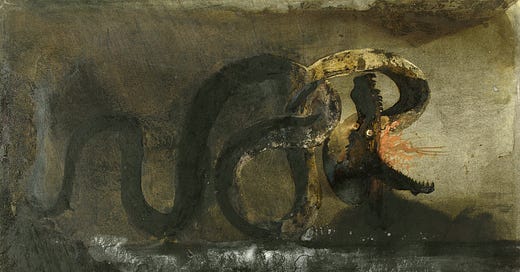



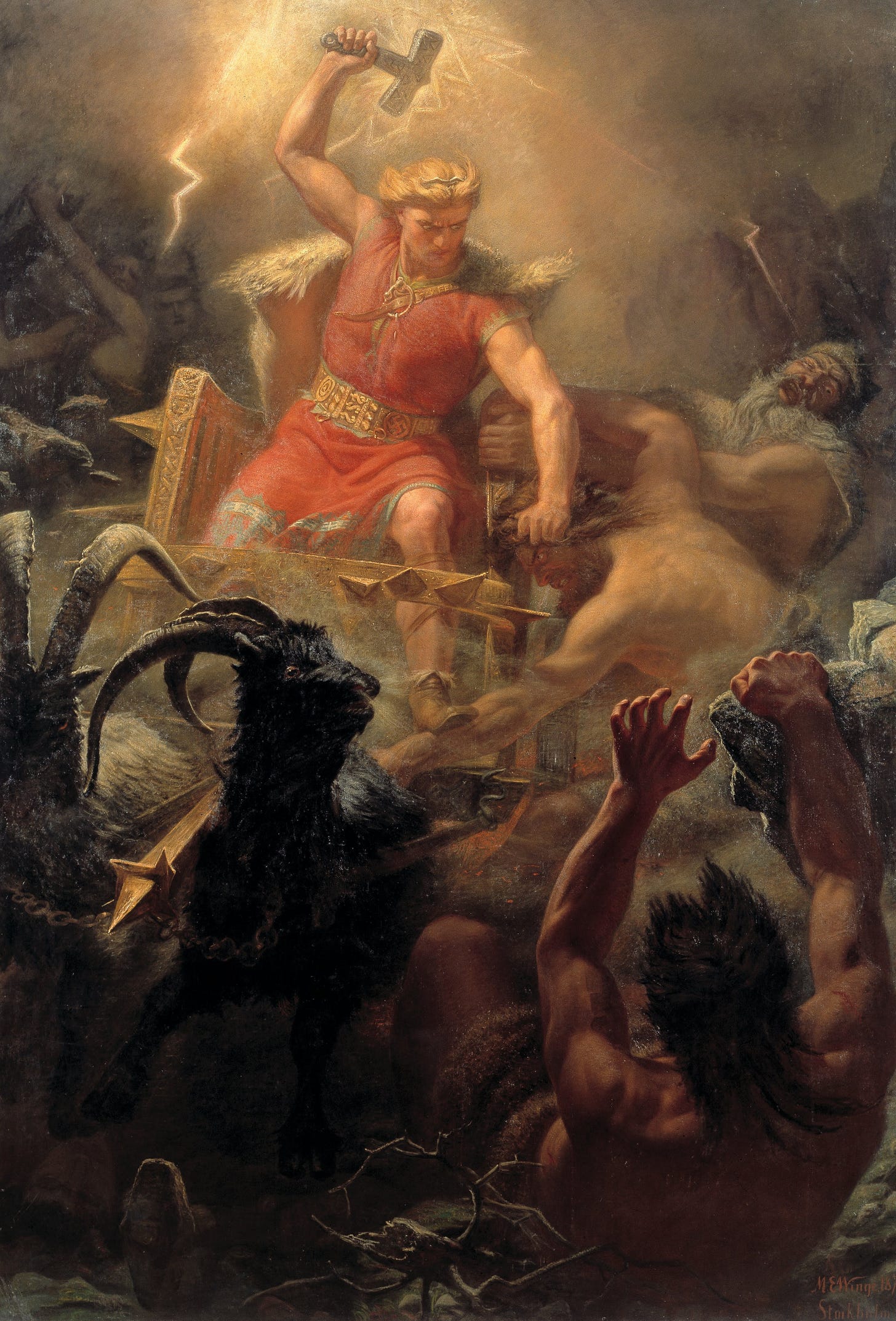
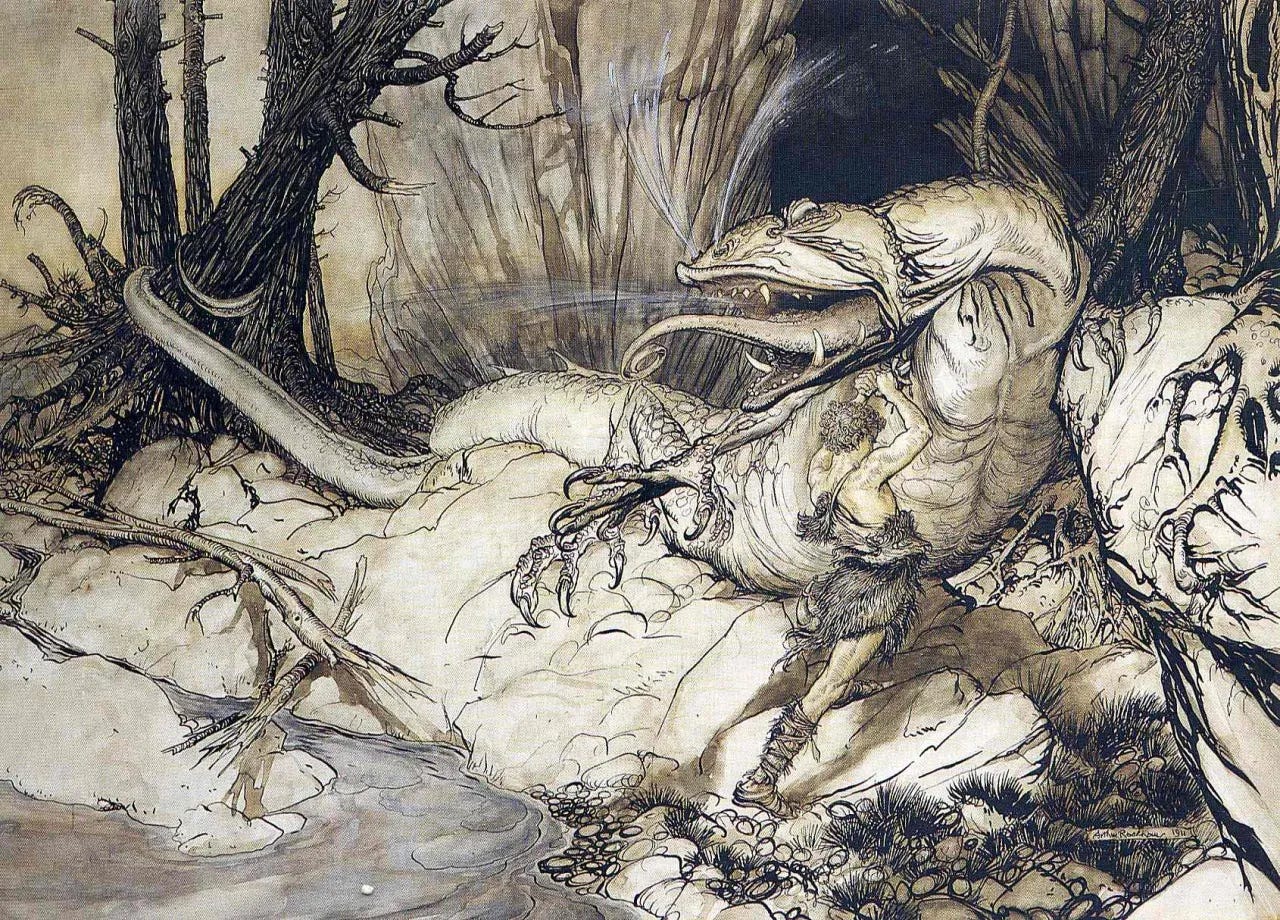
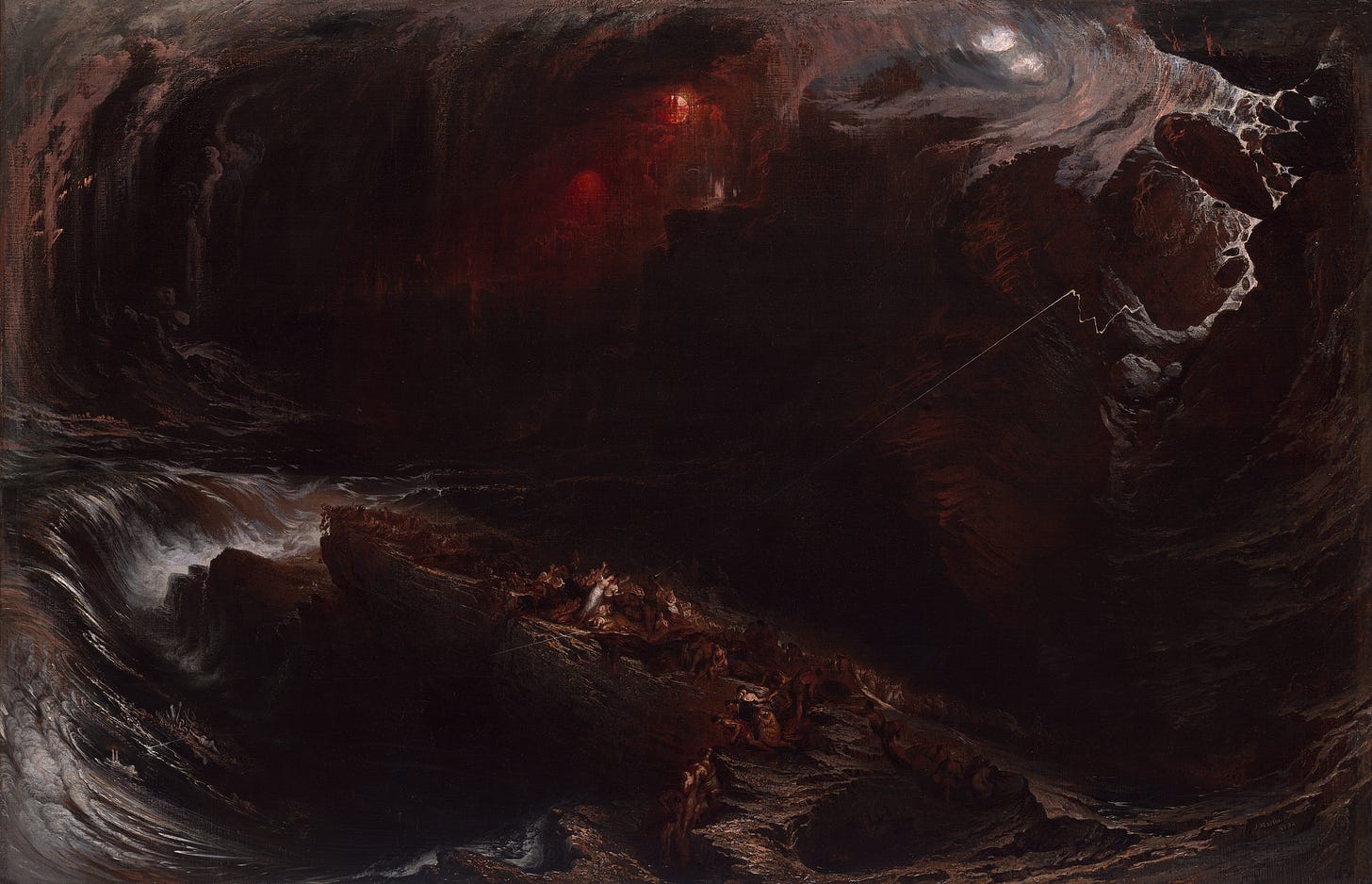
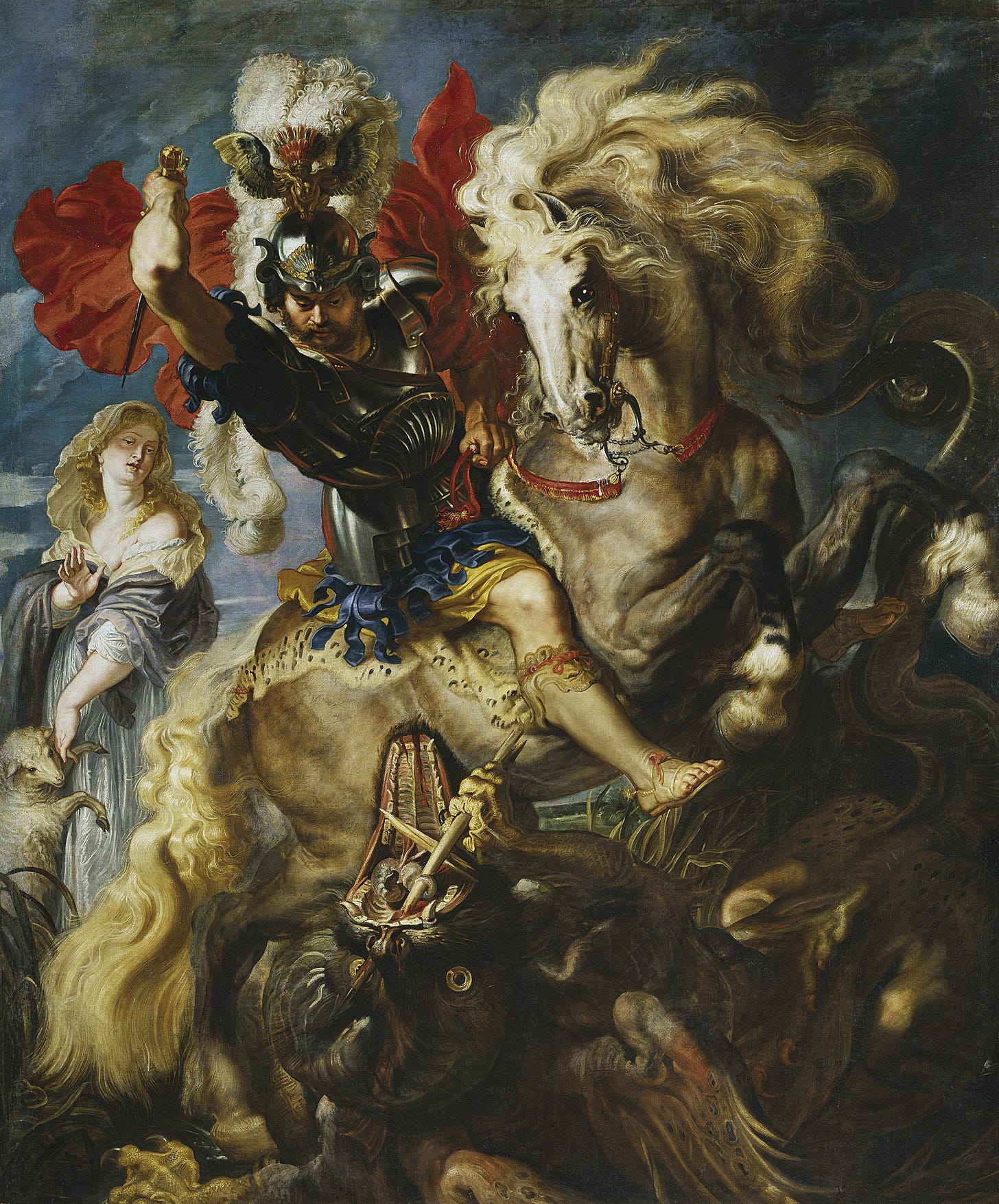
If you want to explore this idea further *and* feel like you're almost completely out of your depth at the same time, I can't recommend Calvert Watkins' How to Kill a Dragon : Aspects of Indo-European Poetics more highly. It's a fascinating, difficult book on linguistics, philology, stories, poetry, and more.
It's one of those books I don't think I'll ever be fully equipped to fully appreciate, but it's a fantastic trip.
It's so interesting to learn about the history of dragons in stories. I never knew of it and always wondered why gold seemed so deeply connected to dragons; for since I was a child I have always loved dragons, but rather for their freedom of flight, majesty and power.